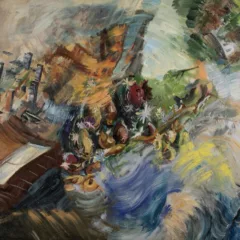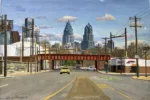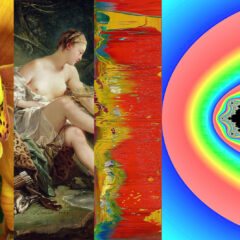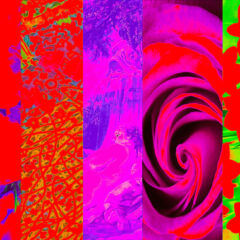Any way you look at it, Scripted at Gross McCleaf Gallery is a pretty open-ended script. While a significant portion of the show in McCleaf’s wonderful gallery space is devoted to painting, there are also strange objects, an installation, photos, and video art.
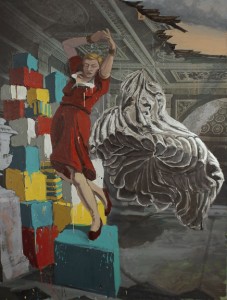
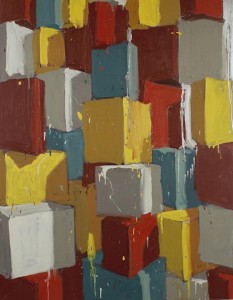
Matt Pinney’s paintings are among the first standouts in the show. His work can be divided into two noticeable styles. On the one hand are works that involve partly-melted, primary-colored cubes, piled up into a full canvas wall for “Package Stack,” and featured as a sort of prop in his mid-action scene “Miranda.”

In contrast, his series Collective Effervescence, four paintings on C-print photographs of a ballroom scene packed with dancers, covers the original photos with thick oil paint to create — the same picture, in paint. The texture here is as visceral as the perceived nostalgia of the dancehall patrons. Pinney’s subtle colors in these works are refreshing next to his bright block works. The low-saturation blues and reds in his almost-grayscale color scheme would be difficult to pinpoint if not for the comparison of all four panels together.
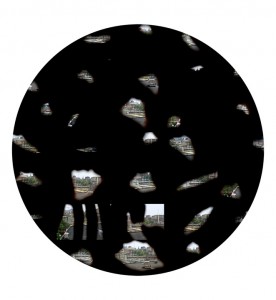
Solange Roberdeau’s photo montages present themselves behind black circular masks with odd-shaped “windows.” Tiny slices of urban landscape are repeated over and over in the window snippets that operate almost like the multiple perspectives of Cubism, if not for the fact that they all seem to share the same angle, and not multiple perspectives. The black area forms negative space that is, in many ways, more interesting than the subject at hand.
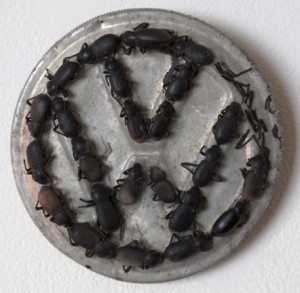
In a show as visually pleasing as Scripted, Edward Carey’s wrench in the works breaks things up a bit. One wall is lined with his small, quaint objects, which are reminiscent of Duchamp. Particularly amusing are the small objects, “Phorest Fone,” a mélange of bark and pine needles in the shape of a cell phone; and “Two Types of Beatles,” a Volkswagen logo (from a VW gas cap) lined with actual dead beetles. Strangely enough considering the name, neither Paul nor George make an appearance in this piece.
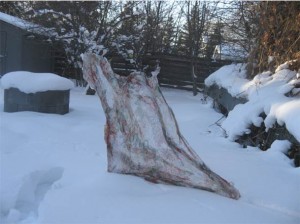
Bernadine Schroyer’s somewhat obtuse photographs of cloth or cloth-like patterns are all untitled, but their enigmas are part of what makes them fun to try and decipher. In a similar vein – aside from its lengthy name – is the wall installation by Colleen Rudolf: “Deer Head, Human Leg, Equal Arm Balance, Plant Needs Water Indicator.” The arm of a scale reminds us of balance and the symbolism hints at different forms of life. It is somewhat crude – lashed together with leather and twine – but, in a way, this draws even more attention to individual necessity for balance.
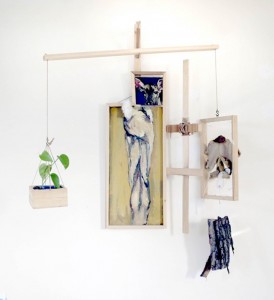
Cora Cohen’s natural, process art paintings, Celia Reisman’s “Gray World,” Deborah Kahn’s speckled segments of thick paint, and Joe Ballweg’s thick outlines and swaths of color round out the show. It would certainly be amiss not to mention the videos in the show as well: Roberdeau’s “Ocean Takes” and Bart O’Reilly’s “All of What’s Left” bear a strong resemblance to Roberdeau’s photos in their ability to both disguise and reveal content.
There is something for almost everyone in this varied and interesting show, which looks great in Gross McCleaf’s large and well-laid-out space. I’ll be curious to see what they follow up with. Scripted is up to Aug. 31.


